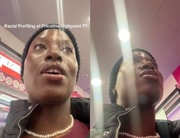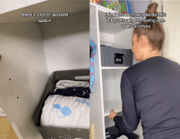Think you're safe? This overlooked online feature might be putting your home at risk
By
Maan
- Replies 0
Home security is something most of us take seriously, whether it’s through locks, alarms or staying alert to unusual activity.
But a new warning from experts has revealed a surprising step many homeowners are skipping—one that could make all the difference.
And while it’s simple to do, some argue it may be drawing the wrong kind of attention.
Homeowners have always gone to great lengths to secure their properties—from installing high-tech alarms to upgrading locks and surveillance systems.
But one often-overlooked detail might be giving criminals an unexpected advantage, and experts warned it’s something you might want to fix as soon as possible.
While it seemed like just another harmless digital feature, it turned out to be a potential goldmine for burglars looking to case a home before making their move.
Officer Ryan Railsback from the Riverside Police Department in Southern California said he’d seen homeowners begin to take action by removing their homes from online mapping views.
‘The crooks are looking for new and innovative ways to victimise people,’ he shared. ‘It’s good for the public to be aware of that and counter what the criminals are already doing.’
Some properties in high-end London neighbourhoods—such as Phillimore Gardens in Kensington, Glebe Place in Chelsea and parts of Knightsbridge—had already vanished from public view, with their façades completely blurred.
And while it might look like a simple case of digital privacy, experts argued that this tactic could do more than just limit exposure—it could help stop would-be robbers in their tracks.
Christopher Herrmann, professor of law and police science at John Jay College of Criminal Justice in New York, explained that the move had quietly existed for years.
He noted it wasn’t just about hiding from curious passers-by, but deterring thieves from picking a target in the first place.
‘Would-be thieves certainly want to scout their locations before they hit them,’ he said, explaining that criminals often searched for images that revealed entrances, security cameras or luxury items left in plain sight.
According to Google, anyone who preferred their property to remain out of view could request to blur it on Street View.
‘Google Street View cars capture images from public roads, which might include your home,’ the website read.
‘If an image contains inappropriate content, or you prefer your home not be shown, you can request it to be blurred. Once Google blurs your home, the blur is permanent. Only the home owner or tenant is eligible to request a house blur.’
The process was fairly straightforward—though not many were aware it even existed.
After locating your address on Street View via Google Maps, you’d need to click ‘Report a problem’ in the bottom right-hand corner of the screen. From there, a form would appear asking for specific details.
‘We’ll review your report as fast as we can,’ Google said. ‘If you entered your email address in the form, we may contact you to get additional information or to update you on the status of your report.’
Still, some security experts cautioned that there may be a trade-off.
While blurring a home might shield it from prying eyes, it could also have the opposite effect—raising suspicions and inadvertently drawing attention.
A lone blurred house on a street full of visible ones might make criminals wonder what’s worth hiding.
Nevertheless, with digital tools now playing a key role in how homes are scouted for burglary, many believed it was better to be cautious.
Combined with traditional measures like reinforced locks and alarm systems, the tactic was yet another way to stay one step ahead.

With technology changing the way we protect our homes, do you think blurring your house is a smart move—or a step too far? Let us know your thoughts in the comments.
In a previous story, we looked at whether security cameras are actually doing the job we expect—because peace of mind isn’t always guaranteed by a flashing light and a recording sign.
For seniors who’ve invested in or are considering home surveillance, it’s important to know what really works and what might be giving a false sense of security.
If you're thinking of taking your home safety up a notch, that piece is well worth a read too.
Read more: Are Security Cameras Really Keeping Your Home Safe? What You Need to Know Before You Buy
But a new warning from experts has revealed a surprising step many homeowners are skipping—one that could make all the difference.
And while it’s simple to do, some argue it may be drawing the wrong kind of attention.
Homeowners have always gone to great lengths to secure their properties—from installing high-tech alarms to upgrading locks and surveillance systems.
But one often-overlooked detail might be giving criminals an unexpected advantage, and experts warned it’s something you might want to fix as soon as possible.
While it seemed like just another harmless digital feature, it turned out to be a potential goldmine for burglars looking to case a home before making their move.
Officer Ryan Railsback from the Riverside Police Department in Southern California said he’d seen homeowners begin to take action by removing their homes from online mapping views.
‘The crooks are looking for new and innovative ways to victimise people,’ he shared. ‘It’s good for the public to be aware of that and counter what the criminals are already doing.’
Some properties in high-end London neighbourhoods—such as Phillimore Gardens in Kensington, Glebe Place in Chelsea and parts of Knightsbridge—had already vanished from public view, with their façades completely blurred.
And while it might look like a simple case of digital privacy, experts argued that this tactic could do more than just limit exposure—it could help stop would-be robbers in their tracks.
Christopher Herrmann, professor of law and police science at John Jay College of Criminal Justice in New York, explained that the move had quietly existed for years.
He noted it wasn’t just about hiding from curious passers-by, but deterring thieves from picking a target in the first place.
‘Would-be thieves certainly want to scout their locations before they hit them,’ he said, explaining that criminals often searched for images that revealed entrances, security cameras or luxury items left in plain sight.
According to Google, anyone who preferred their property to remain out of view could request to blur it on Street View.
‘Google Street View cars capture images from public roads, which might include your home,’ the website read.
‘If an image contains inappropriate content, or you prefer your home not be shown, you can request it to be blurred. Once Google blurs your home, the blur is permanent. Only the home owner or tenant is eligible to request a house blur.’
The process was fairly straightforward—though not many were aware it even existed.
After locating your address on Street View via Google Maps, you’d need to click ‘Report a problem’ in the bottom right-hand corner of the screen. From there, a form would appear asking for specific details.
‘We’ll review your report as fast as we can,’ Google said. ‘If you entered your email address in the form, we may contact you to get additional information or to update you on the status of your report.’
Still, some security experts cautioned that there may be a trade-off.
While blurring a home might shield it from prying eyes, it could also have the opposite effect—raising suspicions and inadvertently drawing attention.
A lone blurred house on a street full of visible ones might make criminals wonder what’s worth hiding.
Nevertheless, with digital tools now playing a key role in how homes are scouted for burglary, many believed it was better to be cautious.
Combined with traditional measures like reinforced locks and alarm systems, the tactic was yet another way to stay one step ahead.
Key Takeaways
- Experts warned that burglars may use online maps to study homes before attempting a break-in.
- Some homeowners have begun blurring their properties on Google Street View to prevent digital scouting.
- Google allows property owners or tenants to permanently blur their homes via a simple request form.
- While the tactic may deter criminals, it could also raise suspicion if only one house on the street is hidden.
With technology changing the way we protect our homes, do you think blurring your house is a smart move—or a step too far? Let us know your thoughts in the comments.
In a previous story, we looked at whether security cameras are actually doing the job we expect—because peace of mind isn’t always guaranteed by a flashing light and a recording sign.
For seniors who’ve invested in or are considering home surveillance, it’s important to know what really works and what might be giving a false sense of security.
If you're thinking of taking your home safety up a notch, that piece is well worth a read too.
Read more: Are Security Cameras Really Keeping Your Home Safe? What You Need to Know Before You Buy








